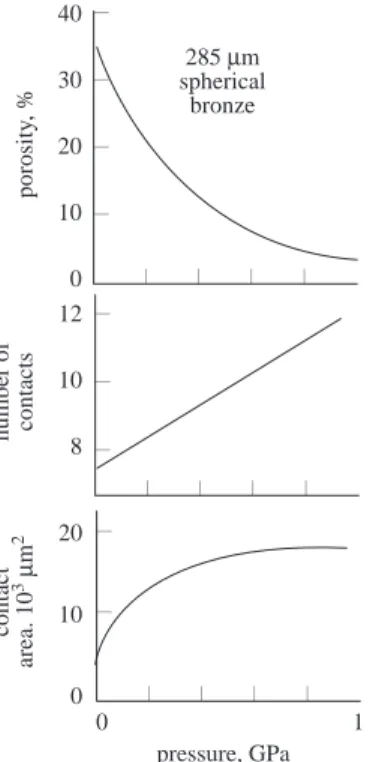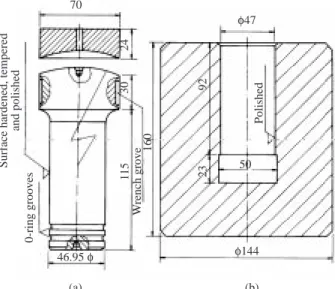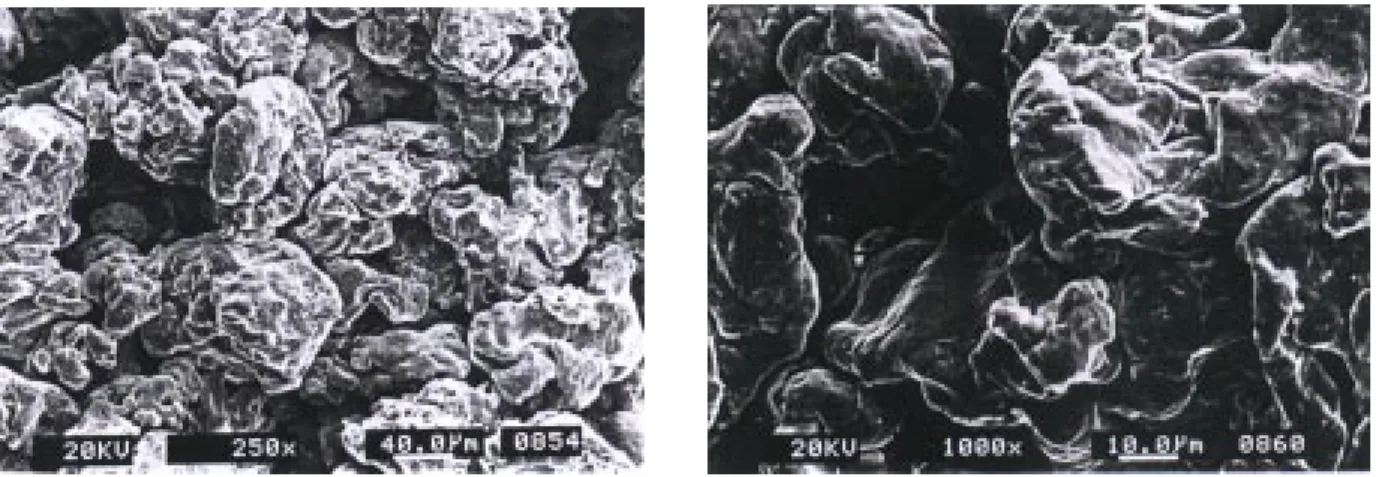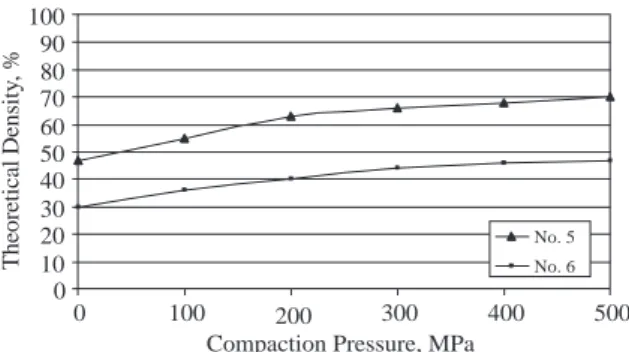c
T ¨UB˙ITAK
Effects of Powder Hardness and Particle Size on the Densification
of Cold Isostatically Pressed Powders
Abdulkadir EKS¸ ˙I
C¸ ukurova University, Mechanical Engineering Department, 01330 Balcalı, Adana-TURKEY
e-mail: akeksi@mail.cu.edu.tr S¨uleyman SARITAS¸
Gazi University, Mechanical Engineering Department, 06570 Maltepe, Ankara-TURKEY
Received 04.07.2001
Abstract
The densification behaviour of aluminium, iron and alumina powders under cold isostatic pressing (CIP) are examined. For this purpose, a unit which can withstand up to 650 MPa pressure was designed and constructed. With this pressure unit, aluminium, iron and ceramic powders, having different hardness values and different particle sizes, were pressed and their mechanical behaviours were investigated at pressures between 100 and 500 MPa. Attained densities were about 100% for aluminium, 90% for iron and 65% for alumina powders. Pressing resulted in significant increases in the microhardnesses of iron and aluminium powders. Light and scanning electron microscopy examinations revealed that severe plastic deformations took place in the powders of aluminium and iron, and no plastic deformation was observed in alumina powders.
Key words: Cold Isostatic Pressing, Metallic and Ceramic Powders, Mechanical Behaviour.
Introduction
Isostatic pressing of metallic and ceramic powders is one of the important achievements in high technol-ogy material processing. In isostatic compaction, a uniform pressure is applied simultaneously to all the external surfaces of a powder body. For this pur-pose the powder is sealed in a flexible container and the assembly is immersed in a fluid which is pres-surized (German, 1984; Lenel, 1980). If the iso-static pressing is done at room temperature, then it is called cold isostatic pressing (CIP). There are two types of CIP toolings available: wet-bag tooling and dry-bag tooling. Wet-bag tooling is more com-mon and versatile (Wheeler, 1986). Compared with die-compaction, CIP provides more uniform pressure distribution within the compact. The major reasons for this are the absence of die-wall friction and the
greater area over which pressure is applied. Further-more, distinct advantages may often be gained from the evacuation of air from the loose powder before compaction. Consequently, CIP provides increased and more uniform density at a given compaction pressure, and relatively defect-free compacts when applied to brittle or fine powders. Another charac-teristic of the process is the elimination of lubricant additives. Their absence eliminates problems associ-ated with lubricant removal prior to or during final sintering (Koerner, 1978; Jackson, 1967; Meiners and McCall, 1987; James, 1983; Koizumu and Nishiara, 1992; Thompson, 1981).
Densification of a powder body is dependent upon a number of powder characteristics. The first group of these are the material features, e.g., hard-ness, work-hardening and cold-welding responses. The second group are the geometrical features, e.g.,
particle shape, particle size and distribution, and the effect of lubricant additives that govern their inter-particle movement and interlocking during pressing (James, 1977). Densification of powders has gen-erally been accepted to take place in three stages (Gethin et al., 1994; Sheppard and McShane, 1980; Fischmeister and Arzt, 1983). In stage one, densifi-cation is produced by rearrangement, where both the packing density and coordination number increase with small levels of pressurisation (less than 0.05 MPa) (Jones, 1960). In stage two, at intermediate pressures, more defined elastic-plastic deformation occurs at interparticle contact areas. As illustrated in Figure 1, coordination number (number of con-tacts) and contact area increase with the increase in pressure while porosity decreases (Fischmeister et al., 1978; German, 1989). With further pressurisa-tion, the number of contacts inreases as particle re-arrangement and sliding occur. Cold welding and/or mechanical interlocking of the particles contribute to the green strength of the compact. For brittle par-ticles, the onset of plastic deformation can lead to fracture, giving way to fragmentation of the original particles and causing densification by repacking of the fragments. At very high compaction pressures, massive deformation occurs, leaving small pores in the junctions of three or more particles. This third
— — — — — — — — — — — — — — — — — — — — — 40 30 20 10 0 12 10 8 20 10 0 pressure, GPa 285 µm spherical bronze contact area. 10 3µ m 2 porosity , % number of contacts 0 1
Figure 1. The compaction behaviour of spherical bronze particles.
stage typically starts at densities over 95% and com-paction pressures in excess of 1 GPa (German, 1989). Kawakita analysed CIP and proposed the follow-ing equation for particulate matter. It relates the relative reduction in volume of the powder mass, C, to pressure, P (James, 1983): C = V0− Vp V0 = 1−Da Dp = abP 1 + bP (1) where Vo is the initial volume of the powder mass, Vp is the volume of the powder mass under pressure P, Dais the relative apparent density of the loose powder mass, Dp is the relative density of powder mass under pressure P and a and b are constant. Rearranging equation (1) gives
P C = 1 ab+ P a (2)
Figure 2 illustrates the application of Kawakita’s equation of state for a series of monosize fractions of metal powders pressed over a pressure range of 77-770 MPa. The well defined linearity is typical of Kawakita’s equation the slope is 1/a, while the in-tercept at zero pressure on the P/C axis is given by 1/ab. The generally accepted interpretation of the constant “a” is taken to be a measure of the initial (loose) porosity, 1-Da, of the powder.
— — — — — — — — — — — — — 2000 1600 1200 800 400 0 P/C Mpa 100 200 300 400 500 600 700 800
COMPACTING PRESSURE, MPa ATOMISED COPPER SPONGE IRON STAINLESS STEEL
Figure 2. Kawakita relationships for monosize fractions of metal powders.
Materials and Methods
CIP Unit: A CIP unit (wet type) consisting of a compression piston and a pressure chamber was designed and constructed (Figure 3). Pressures of up to 650 MPa were obtained in the chamber by the application of force through a 2000 kN capacity testing machine (ELE). The piston and the chamber are made of SAE 1040 steel and heat treated to a hardness of 60 HRC. Their cylindrical surfaces were ground to have a roughness of Ra = 0.3 µm. Wa-ter and mineral oils were used as the pressurizing media. A copper tube (Figure 4) was used as the flexible container for the powder mass. The internal volume of the flexible container was Vi = 4.0 cm3. The air in the flexible container was evacuated by vacuum pump up to 10−2torrs.
70 24 30 11 5 160 W rench grove 0-ring grooves 46.95 φ
Surface hardened, tempered
and polished 92 23 φ144 50 Polished φ47 (a) (b)
Figure 3. (a) Compression piston, (b) Pressure body.
φ5 φ12.7 12.7 30 ° 20 0.7 2.5 40
Figure 4. Flexible container.
CIP: The specifications of the powders used in this study are given in Table 1. Each powder was sieved to different size fractions. Aluminium (produced at Gazi University), iron (H¨oganas ASC100.29) and alumina (Aldrich) powders were used. One of the end caps of the flexible container was first brazed and then it was filled with the pow-der sample was filled in. Later, the other end cap was brazed. The total volume of the flexible container before (V0) and after (V) pressing was measured
us-ing a graduated measurus-ing cylinder accordus-ing to the Archimedes principle. The flexible container was im-mersed into the pressure chamber, the piston was placed into the hole and then the pressures of 100 to 500 MPa was applied using a 2000 KN capacity ELE testing machine. Volume change (∆V = V0
-V) in the flexible container is due to densification of the powders since the volume of the copper tube is constant. The volume of the pressed powder, Vp is given as
Vp= Vi− ∆V (3)
The mass density Dp of the pressed powder may be calculated as
Dp= W Vp
(4) where W is the weight of the powder inside the flex-ible container. The percent theoretical density Dtof the pressed powder is then determined by the rela-tion
Table 1. Characteristics of powders used.
Powder, (No) Manufacturing Apparent Hardness Size Range
Method Densit, % HV µm Aluminium, (1) Atomised 60 18 -45 (2) (gas) 50 -150 + 106 Iron, (3) Reduced 40 65 -63 + 45 (4) 35 -150 + 106 Alumina, (5) Fused 47 2000 -45 + 10 (6) 30 -106 + 75
Dt(%) = Dp
D x100 (5)
where D is the picnometric density of the powder material.
Metallography: Deformed flexible containers were cut perpendicular to their axis and then mounted in plastic for metallographic preparation. The copper tube of some of the deformed flexible containers was carefully cut partly and then the sam-ple was broken to cause fractured surfaces of com-pressed powders. The morphology and microstruc-ture of the pressed samples were examined by scan-ning electron microscope (SEM) and light micro-scope. It was not possible to prepare samples of alu-mina for exaalu-mination since they were loose powders. The same difficulty was encountered for iron sam-ples pressed below 200 MPa and aluminium samsam-ples pressed below 100 MPa. In addition, the change in microhardness was measured for aluminium and iron samples embedded in plastic.
Experimental Results and Discussion
In this study, aluminum, iron and alumina powders of hardnesses and different sizes were pressed to 100-500 MPa using a cold isostatic pressing unit and their densification behaviour was investigated. An empty flexible container where the two end caps at both ends were brazed was immersed into the chamber and pressure was applied as a test of the deforma-tion behaviour of an empty flexible container. It was observed that the container become totally flat (Fig-ure 5(b)) under an applied press(Fig-ure of 20 MPa, which is rather low compared to the pressures applied for the densification of powders. The deformation of the flexible container which was filled with powders is not uniform and buckling of the tube took place as seen in Figure 5. This is attributed to the constraints applied by the brazed end caps to the deformation of the copper cylinder.
CIP of aluminium powders was done for two dif-ferent powder particle sizes (Table 1). The alu-minium powder particles before pressing ligamental in shape as shown in Figure 6 (a). The packing den-sity of powder No.1 is 60% of the theoretical denden-sity (TD), and of powder No.2 is 50% of the TD. As can be seen in Fiure 7, the densification in both powders reached 98% of the TD at a pressure of 400 MPa, and stayed constant up to 500 MPa. The remaining 2% may be attributed to voids between the particles.
The SEM examination of the specimen pressed at 100 MPa shows the initiation of plastic deformation (Figure 6(b)). At this stage, the point contacts were partly replaced with plane contacts. In specimens pressed to 300 and 400 MPa, initial particle shapes totally disappeared and plane contacts were formed as seen in Figure 6(b) and 6(c). In cold isostati-cally pressed monosized metal powders a spherical particle turns into a dodecahedron shape when fully densified. The light microscope examination showed uniform densification as seen in Figure 8. The mi-crohardness of aluminium increased from 18 HV to 63 HV with increasing pressure up to 500 MPa, even though the densification stopped at 400 MPa (Figure 9). This three-fold increase in microhardness is the result of work hardening taking place due to severe plastic deformation during CIP.
Figure 5. The deformation of the flexible container under applied pressures.
The densification of iron powders of two different particle sizes was investigated in two different CIP procedures: the first group without removing the air between the powder particles (as in the case of alu-minium) and the second group with air removed up to a vacuum of 10−2 torrs. Original iron powder is seen to have an irregular and porous structure be-cause of water atomisation as shown in Figure 10 (a). The densification behaviour of iron powders ders with two different particle size is similar, as seen in Figure 11. At 100 MPa pressure and be-low no compact was produced and the powders were loose. Pressing at 100 MPa pressure produced a den-sity increase of 17% and powders were loose, which means that the main densification stage was repack-ing with very little plastic deformation. The ten-sile strength of iron powders may be considered to be about 21.6 kg/mm2 (216 MPa) since the tensile
strength is about one third of the hardness. Addi-tionally, some of the applied pressure goes to inter-particle friction since no lubricant addition was done (German, 1984; Sarıta¸s, 1995). Thus up to applied pressure in the order of 250 MPa most of the densi-fication is due to the repacking of particles. In iron powders pressed at 400 and 500 MPa, plastic defor-mation was initiated at contact surfaces by yielding
and this caused local deformation. Thus the local deformation, under excessive pressure, of the mate-rial into the neighbouring voids increased the density. The light microscope examination (Figure 12) shows that porosity decreased with increasing pressure, the initial shape of particles changed completely and ho-mogenous densification took place.
Figure 6. SEM micrographs of aluminium powders: (a) Before compaction, (b) 100 MPa, (c) 400 MPa, (d) 500 MPa.
— — — — — — — — — — — 0 100 200 300 400 500
Compaction Pressure, MPa Powder No.1 Powder No.2 Aluminium 100 90 80 70 60 50 Theoretical Density , %
Figure 8. Light microscope photographs of aluminium compact: (a) 300 MPa (100X), (b) 400 MPa (500X). — — — — — — — — — — 110 100 90 80 70 60 50 40 30 20 10 Microhardness, HV — — — — — — 0 100 200 300 400 500
Compaction Pressure, MPa Iron Aluminium
Figure 10. SEM micrographs of iron powders: (a) Before compaction, (b) 200 MPa, (c)300 MPa, (d) 500 MPa. 20 30 40 50 60 70 80 90 100 0 100 200 300 400 500
Compaction Pressure, MPa
Theoretical Density , % No.3 Vacuum No.3 No Vacuum No.4 Vacuum No.4 No Vacuum
Figure 11. Densification in iron powders for No. 3 and No. 4.
Figure 12. Light microscope photographs of iron compact: (a) 300 MPa (100X), (b) 400 MPa (500X).
The density increase of severely hard alumina powders reached only 20% for 500 MPa applied pres-sure (Figure 13). The increase in densification under
the applied pressures is attributed to the repacking of powders since the applied pressure was below the yield strength of alumina particles.
0 10 20 30 40 50 60 70 80 90 100 0 100 200 300 400 500
Compaction Pressure, MPa
Theoretical Density
, %
No. 5 No. 6
Figure 13. Densification in alumina powders.
Conclusion
1. Full densification was almost attained with CIP in soft and easy to deform aluminium
pow-ders.
2. For iron powders of medium hardness and plas-tic behaviour, density of 82% of the TD with-out removing air and 92% of the TD with re-moving air to a vacuum of 10−2 torrs were achieved at 500 MPa.
3. The microhardness of aluminium powders in-creased three-fold while the microhardness of iron powders increased about two-fold during CIP at pressures up to 500 MPa.
4. Severely hard alumina powders attained 70% of the TD under 500 MPa pressure. No plastic deformation was observed in alumina powders. Densification is due to the rearrangement of powders.
References Eksi, A. and Saritas, S., “The Isostatic Pressing of
Metallic and Ceramic Powders”, 6th Denizli Mate-rial Symposium, Denizli, 363-373, 1995.
Fischmeister, H.F., and Arzt, and E. “Densification of Powders by Particle Deformation”, Powder Met-allurgy, 26, (2), 82-88, 1983.
Fischmeister, H.F., Arzt, E., Olsson, L.R., “Parti-cle Deformation and Sliding during Compaction of Spherical Powders: A Study by Quantitative Met-allography”, Powder Metallurgy, 21, (4), 179-187, 1978.
German, R.M., Particle Packing Characteris-tics, Metal Powder Industries Federation (MPIF), Princeton, NJ, 1989.
German, R.M., Powder Metallurgy Science, Metal Powder Industries Federation (MPIF), Princeton, NJ, 1984.
Gethin, D., Ariffin, A.K., Tran, D.V. and Lewis, R.W., “Compaction and Ejection of Green Pow-der Compacts”, PowPow-der Metallurgy, 37, (1), 42-54, 1994.
Jackson, H.C., “Isostatic Pressing of Powdered Ma-terials”, Perspectives in Powder Metallurgy: Fun-damentals, Methods and Applications, New York, 1967.
James, P.J., “Principles of Isostatic Pressing”, Iso-static Pressing Technology, Edited by P.J., James, Applied Science Publishers Ltd., 15-23. 1983. James, P.J., “Particle Deformation During Cold Iso-static Pressing of Metal Powders”, Powder Metal-lurgy, 20, (4), 199-203, 1977.
Jones, W.D., Fundamental Principles of Powder Metallurgy, Edward Arnold Publishers, London, 1960.
Koerner, M., “Triaxial Stress State Compaction of Powders”, Powder Metallurgy Processing, Edited by H.A. Kuhn and A. Lawley, 1978.
Koizumu, M. and Nishihara, M., Isostatic Pressing Technology and Applications, Elsevier Science Pub-lishers Ltd., 1992.
Lenel, F.V., Powder Metallurgy Principles and Applications, Metal Powder Industries Federation (MPIF), Princeton, NJ, 1980.
Meiners, K.E., and McCall, J.C., “Isostatic Press-ing”, Section II, Powder Metallurgy for Full Density Products, Edited by K.M. Kulkarni, Metal Powder Industries Federation (MPIF) Princeton, NJ, 1987. Powell, R.A., “Isostatic Compaction of Metal Pow-ders in Conventional Molding Tools”, International Journal of Powder Metallurgy, 1 (3), 13-19, 1965. Sarıta¸s, S., Engineering Metallurgy and Materi-als, Gazi Univ., Muh. Mim. Fak., Yayını, Maltepe-Ankara, 1995.
Sheppard, T. and McShane, H.B., “Strength of Cold-Pressed Compacts”, Powder Metallurgy, 23, (3), 120-124, 1980.
Thompson, R.A., “Mechanics of Powder Pressing: I, Model for Powder Densification”, American Ce-ramic Society Bulletin, 60, (2), 273-279, 1981. Wheeler, F.S., “Comparison of Wet-Bag Vs Dry-Bag Isostatic Pressing”, Ceramic Engineering Proc., 7 (11,12) 1242-1247, 1986.






